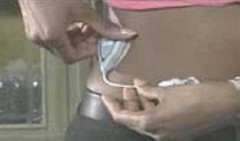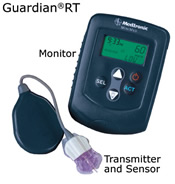Continous Glucose Monitoring
 Sometimes my diabetes really gets to me. This is year twelve for me and I have no (known) complications and I'd like to keep it that way. I do pretty well, with blood sugars averaging around 130-160. Ideal is 100, but I'm not doing to bad. However, I had some Indian food last night and I was up until 4AM "chasing blood sugars." I even took an intra-muscular insulin shot in an attempt to bring it down. It can be very tedious.
Sometimes my diabetes really gets to me. This is year twelve for me and I have no (known) complications and I'd like to keep it that way. I do pretty well, with blood sugars averaging around 130-160. Ideal is 100, but I'm not doing to bad. However, I had some Indian food last night and I was up until 4AM "chasing blood sugars." I even took an intra-muscular insulin shot in an attempt to bring it down. It can be very tedious.
 The insulin pump is nice, but folks often forget that it's just a delivery device. It pumps insulin through a tube into me, and that's it. All the input comes from the blood sugar meter via a finger stick.
The insulin pump is nice, but folks often forget that it's just a delivery device. It pumps insulin through a tube into me, and that's it. All the input comes from the blood sugar meter via a finger stick.
However, very soon I should be able to get a Continuous Glucose Monitoring System. This would be yet another device that'd be 'implanted/stuck' to me, but it would talk wirelessly and continuously to the pump.
This device is rolled out in seven cities; they are apparently taking it slow. I can't wait. I have no words to explain to you, dear reader, what it feels like to prick your finger 6 to 10 times a day for 365 days a year for over a decade. You get so addicted (in a necessary way) to the feedback provided by the number that is your blood sugar. Your blood sugar's current level becomes a sixth sense that is as important as any of the other five.
Every time I prick my finger it costs about 80 US cents. It gets spendy. Sometimes I get a little Mulderesque and wonder if they will ever cure diabetes as it's so profitable. Getting my blood sugar reader 10 times a day isn't enough. If you refer back to my Diabetes Airplane Analogy, you wouldn't want to check the altimeter in your airplane only ten times. you'd want to check it continuously.
This continuous meter will connect to me on the other side of my body - the opposite side than the pump - and talk to the pump wirelessly. I'd still have to make the decisions and "close the loop." NONE of this happens automatically. Insulin is never delivered without me deciding. Getting the BG (Blood Glucose) reading continuously will make my life easier.
Here's a little (I think) exclusive. I got this from a "source"...it's a PDF version of the training manual for the new Continuous Meter:
File Attachment: Paradigm Real teaching 1.pdf (999 KB)
About Scott
Scott Hanselman is a former professor, former Chief Architect in finance, now speaker, consultant, father, diabetic, and Microsoft employee. He is a failed stand-up comic, a cornrower, and a book author.
About Newsletter
I keep my glucose in the same neighborhood as you, generally targeting 110 but occassionally getting as high as 160-180 after a meal or as low as 80 after a workout. Without fail, I'm always aroun 150 first thing in the morning, thanks to the dawn phenomenon.
Regarding testing often, I can't agree with you more. They tell you "twice a day", but since most people eat three times a day, and take part in several more activities that impact blood sugar, I always thought that was way low. To get a little help from my insurance, I ask my doctor to specifically write the prescription for my test strips for testing four times a day. That way, when the mail-order pharmacy calculates a "90 day supply," I'm getting a decent number of strips.
So I don't test 10 times a day, but it's more from a lack of strips than apathy or fear of the lancet. Interestingly, I've found that forearm testing is, for me anyway, just as accurate as fingertip testing.
I'm not making light of you diabetes Scott, it's just that as I read this into my head popped these outsourcing guys (who I've been thinking a lot about recently).
Hopefully this new device will make it to Portland PDQ and make your life a whole load easier.
This is interesting. I just recently wrote a short survey paper on continuous glucose monitoring technology (I am in grad school for medical engineering), and looked at the continuous glucose monitoring systems available. I did not have information about this particular system, but Mimimed's name certainly popped up a bunch.
I am not diabetic myself, but I've subjected myself to finger pokes every half hour for a full day once, in the interest of science (aka, a physiology class lab), so I have some idea of the pain involved. I am currently enrolled in a biosensors class, and glucose monitoring is mentioned quote often - it is basically the holy grail of all biosensor research. So I was very excited to read that there is now a system with a direct connection to an insulin pump (aka artificial pancreas) that has cleared most of the FDA hurdles. However, there are issues with these systems that look to be unsolved (really, sidestepped) by this particular system. I thought I'd enumerate them here for no particular reason:
1. This is still an invasive sensor. There *are* several non-invasive glucose sensors under development - the most promissing ones shine a well-calibrated source of light at an area of skin, and measure either the reflected or scattered light. Tissue glucose content turns out to affect the translucency properties quite a bit. Accuracy is still an issue, but there were publications in peer-reviewed journals in 2000-2001 that claimed sensitivity only an order of magnitude less than the finger-poke strips. Alternatively, there are the so-called transdermal sensors that apply a small current to a patch of skin to literally pull the electronegative glucose molecules out through skin and onto the sensor surface (which looks like a large wristwatch). Both of these cause no irritation to skin.
2. The calibration aspect is still lousy. If I read the PDF correctly, every 72 hours you have to stick one of these things in (I am assuming the form factor to be something like a needle with a platform), and then you have to poke your finger 3-4 times to get the blood plasma readings which you use to calibrate your sensor. That's still a lot of poking.
3. The exact quantity that's being measured is uncertain. This type of sensor *does not* measure the glucose content in blood plasma, like the finger pokes do. The needle is inserted into the subcutaneous tissue, and measures glucose content of interstitial fluid. It turns out that the relationship between how much glucose you have in your blood and interstitial fluid is very much non-trivial, and (to the best of my knowledge) has not been reduced to any kind of sure-fire rule yet. Usually, it is just a linear function - e.g. 75% of what you have in blood, but when the blood glucose level changes rapidly, the glucose content in interstitial fluid may either pull ahead or lag behind that of blood. As a diabetic, it is exactly these rapid change conditions that you would care about. I will go out on a limb and make the prediction that your device will produce at least some false alarms: the manufacturers will certainly want to protect themselves from liability by erring way on the safe side. If it does not, the state of art must have advanced significantly since papers I read for my research.
4. A kind of follow-up to #3, needle-type sucutaneous systems suffer from biofouling. Body immune system is not fond of needles being showed into it, nor is it a big fan of the glucose oxidase reaction that takes place at the tip of the sensor. For this reason, your sensor becomes useless after 72 hours - it is covered by macrophages to such a degree that glucose no longer can get through. The problem is worse than having to continuously replace the sensor, however. Your immune system activity will raise the energetic requirements of the local tissue, causing your body to increase the local glucose supply. So, by sticking your sensor in, you just increased the local glucose content (remember, this isn't blood plasma but more stable interstitial fluid, so you will get pooling and releasing effects). Working backwards from what you measure to what the rest of your body experiences is non-trivial, and as far as I know not settled at all academically.
I recommend this paper for a good overview of continuous glucose monitoring technology that is accessible to anyone familiar with the problem: Sensors for glucose monitoring: technical and clinical aspects (http://www.ncbi.nlm.nih.gov/entrez/query.fcgi?cmd=Retrieve&db=PubMed&list_uids=11307176&dopt=Abstract)
All of this said, it's very exciting that these systems are making more and more of an appearance on the market. While this sensor is not perfect, it is a step towards making a better one, whichever form it takes. Kudos to Minimed for developing a system that met the very rigorous FDA requirements for bot accuracy and ease of patients use!
Cheers,
Alex
P.S. Just tried to submit a message with a link, and got a stack trace back... you might want to turn off showing custom errors to the internet.
I have an uncle with Type 1 as well. Came on suddenly when he was 30. When he didn't show up for Christmas dinner that year, my other uncle went to take him a plate of food after the party and found him nearly in a coma on the living room couch. Close one that.
That's over 20 years ago now. He's doing fine but I know what a PITA it is. I hope for all that they find better ways to manage, if not cure this disease.
http://www.ctv.ca/servlet/ArticleNews/story/CTVNews/20060316/diabetes_break_060316/20060317?hub=Health
FYI, this page:
http://www.hanselman.com/blog/CategoryView.aspx?category=Diabetes
is showing dates in Spanish.
Comments are closed.

Okay, diabetes is no laughing matter and that's probably a bad joke and I'm going to H-E-double-hockey-sticks, but any device that hooks into the human body and works wirelessly is cool (and I'm actually learning a lot from your diabetes category, especially the airplane analogy).
Now I'm just waiting for the GPS enabled RFID chip I can implant into my head and get DirectTV streaming from it.